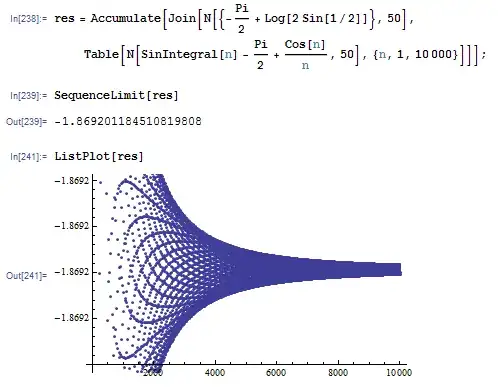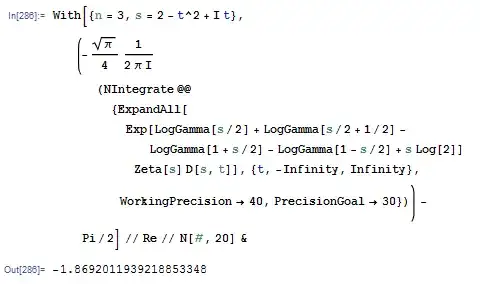A bit late, but here's a more general calculation, which explains where the mysterious $\frac{\pi}{4}$ in Raymond Manzoni's answer comes from:
We will use the Fourier series
$$ \sum \limits_{n=1}^\infty \frac{\cos (ny)}{n} = - \log \left[2 \left \lvert \sin \left(\frac{y}{2}\right) \right \rvert \right] \, , \, y \in \mathbb{R} \setminus 2 \pi \mathbb{Z} \, , \tag{1} $$
and the series
$$ \log[\lvert \operatorname{sinc}(\pi z) \rvert] = \sum \limits_{k=1}^\infty \log \left(1 - \frac{z^2}{k^2}\right) \, , \, z \in \mathbb{R} \setminus \mathbb{Z} \, , \tag{2}$$
connected to Euler's sine product formula.
For $x \in \mathbb{R}^+ \setminus \mathbb{N}$ let
\begin{align}
s(x) &= \sum \limits_{n=1}^\infty \left[\frac{\pi}{2} - \operatorname{Si}(2 \pi x n)\right] = \sum \limits_{n=1}^\infty ~ \int \limits_{2 \pi x n}^\infty \frac{\sin(t)}{t} \, \mathrm{d}t \overset{\text{IBP}}{=} \sum \limits_{n=1}^\infty \left[\frac{\cos(2 \pi x n)}{2 \pi x n} - \int \limits_{2\pi x n}^\infty \frac{\cos(t)}{t^2} \, \mathrm{d} t\right] \\
&= \sum \limits_{n=1}^\infty \left[\frac{\cos(2 \pi x n)}{2 \pi x n} - \int \limits_1^\infty \frac{\cos(2 \pi x n u )}{2 \pi x n u^2} \, \mathrm{d} u\right] = \sum \limits_{n=1}^\infty \int \limits_1^\infty \frac{\cos(2\pi x n)-\cos(2 \pi x n u )}{2 \pi x n u^2} \, \mathrm{d} u \\
&\stackrel{(1)}{=} \frac{1}{2 \pi x} \int \limits_1^\infty \log\left(\left\lvert\frac{\sin(\pi x u)}{\sin(\pi x)}\right\rvert\right) \, \frac{\mathrm{d} u}{u^2} \, .
\end{align}
Interchanging summation and integration is allowed here, as can be shown by integrating by parts one more time. Next we write
$$ s(x) = \frac{1}{2 \pi x} \int \limits_1^\infty \left[\log(u) + \log\left(\left\lvert\frac{\operatorname{sinc}(\pi x u)}{\operatorname{sinc}(\pi x)}\right\rvert\right)\right] \, \frac{\mathrm{d} u}{u^2} = \frac{1}{2 \pi x} \left[1 + \int \limits_1^\infty \log\left(\left\lvert\frac{\operatorname{sinc}(\pi x u)}{\operatorname{sinc}(\pi x)}\right\rvert\right) \, \frac{\mathrm{d} u}{u^2} \right] . $$
At this point we would like to use (2), but here interchanging summation and integration is more problematic. It works on any finite interval of integration by dominated convergence, but not on $(1,\infty)$. We therefore choose $R > 1$ such that $x R \notin \mathbb{N}$ and compute
\begin{align}
& \phantom{={}} \int \limits_1^R \log\left(\left\lvert\frac{\operatorname{sinc}(\pi x u)}{\operatorname{sinc}(\pi x)}\right\rvert\right) \, \frac{\mathrm{d} u}{u^2} \stackrel{(2)}{=} \sum \limits_{k=1}^\infty \int \limits_1^R \log \left(\left \lvert \frac{k^2 - x^2 u^2}{k^2-x^2} \right \rvert \right) \, \frac{\mathrm{d} u}{u^2} \\
&\!\overset{\text{IBP}}{=} \sum \limits_{k=1}^\infty \left[\log \left(\left \lvert \frac{k^2 - x^2 R^2}{k^2-x^2} \right \rvert \right) \left(\frac{x}{k} - \frac{1}{R}\right) + \int \limits_1^R \frac{2 x^2 u}{k^2 - x^2 u^2} \left(\frac{x}{k} - \frac{1}{u}\right) \, \mathrm{d} u\right] \\
&= \sum \limits_{k=1}^\infty \left[\log \left(\left \lvert \frac{k^2 - x^2 R^2}{k^2-x^2} \right \rvert \right) \left(\frac{x}{k} - \frac{1}{R}\right) - \frac{2 x^2}{k} \int \limits_1^R \frac{\mathrm{d} u}{k + x u}\right] \\
&= \sum \limits_{k=1}^\infty \left[\frac{x}{k} \left(\log \left(\left \lvert \frac{k + x}{k-x}\right\rvert\right) - \log \left(\left \lvert \frac{k + xR}{k-xR}\right\rvert\right) \right) - \frac{1}{R} \log \left(\left \lvert \frac{k^2 - x^2 R^2}{k^2-x^2} \right \rvert \right) \right] \\
&\stackrel{(2)}{=} 2 x [f(x) - f(x R)] - \frac{1}{R} \log\left(\left\lvert\frac{\operatorname{sinc}(\pi x R)}{\operatorname{sinc}(\pi x)}\right\rvert\right) .
\end{align}
Here, we have introduced
$$ f \colon \mathbb{R}^+ \setminus \mathbb{N} \to \mathbb{R}^+ \, , \, f(t) = \sum \limits_{k=1}^\infty \frac{1}{2k} \log \left(\left \lvert \frac{k + t}{k-t}\right\rvert\right) = \sum \limits_{k=1}^\infty \frac{1}{k} \operatorname{artanh} \left[\min \left(\frac{k}{t},\frac{t}{k}\right)\right] .$$
Letting $R \to \infty$, we find
$$ s(x) = \frac{1}{2\pi x} + \frac{f(x) - f(\infty)}{\pi} \, .$$
The limit
\begin{align}
f(\infty) &= \lim_{t \to \infty} f(t) = \lim_{\varepsilon \to 0^+} f\left(\frac{1}{\varepsilon}\right) = \lim_{\varepsilon \to 0^+} \varepsilon \sum \limits_{k=1}^\infty \frac{1}{\varepsilon k} \operatorname{artanh} \left[\min\left(\varepsilon k, \frac{1}{\varepsilon k}\right)\right] \\
&= \int \limits_0^\infty \frac{\operatorname{artanh} \left[\min\left(r, \frac{1}{r}\right)\right]}{r} \, \mathrm{d} r = 2 \int \limits_0^1 \frac{\operatorname{artanh} (r)}{r} \, \mathrm{d} r = 2 \frac{\pi^2}{8} = \frac{\pi^2}{4}
\end{align}
can be computed using improper Riemann sums (see this question; the monotonicity condition can be circumvented by splitting the series at $k = \lfloor 1/\varepsilon \rfloor$ and thus the integral at $r=1$). Therefore,
$$ s(x) = \frac{1}{2\pi x} - \frac{\pi}{4} + \frac{1}{\pi} \sum \limits_{k=1}^\infty \frac{1}{k} \operatorname{artanh} \left[\min \left(\frac{k}{x},\frac{x}{k}\right)\right] $$
holds for $x \in \mathbb{R}^+ \setminus \mathbb{N}$. In particular, your series is
$$ - s\left(\frac{1}{2\pi}\right) - \frac{\pi}{2} = -1 - \frac{\pi}{4} - \frac{1}{\pi} \sum \limits_{k=1}^\infty \frac{1}{k} \operatorname{artanh} \left(\frac{1}{2 \pi k}\right) . $$

